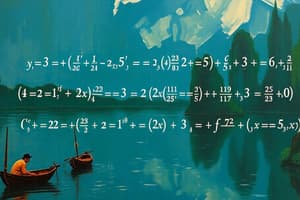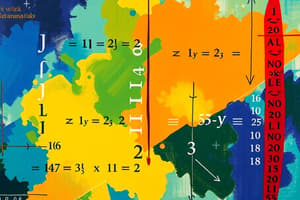Podcast
Questions and Answers
Which of the following is true about quadratic equations?
Which of the following is true about quadratic equations?
- They include terms with a variable raised to the second power. (correct)
- They do not have any real roots.
- They are always linear in nature.
- They can only have one solution.
What does the Pythagorean Theorem apply to?
What does the Pythagorean Theorem apply to?
- All types of triangles.
- Only right triangles. (correct)
- Only obtuse triangles.
- Right triangles and quadrilaterals.
Which operation is performed during factoring of an algebraic expression?
Which operation is performed during factoring of an algebraic expression?
- Multiplying all terms by a variable.
- Combining like terms.
- Adding constants together.
- Rewriting as a sum of products. (correct)
What is the formula used to calculate the distance between two points in a coordinate system?
What is the formula used to calculate the distance between two points in a coordinate system?
In geometry, what defines a circle?
In geometry, what defines a circle?
ما هي العناصر الرئيسية للأعداد الحقيقية؟
ما هي العناصر الرئيسية للأعداد الحقيقية؟
أي من الخيارات التالية تُعتبر دالة واحدة إلى واحدة؟
أي من الخيارات التالية تُعتبر دالة واحدة إلى واحدة؟
ما هو المفهوم الذي يُستخدم لقياس الميل في الدوال الخطية؟
ما هو المفهوم الذي يُستخدم لقياس الميل في الدوال الخطية؟
ما هو مثال لعلاقة مثلثية تستخدم في مثلث قائم الزاوية؟
ما هو مثال لعلاقة مثلثية تستخدم في مثلث قائم الزاوية؟
ما هو المصطلح المستخدم لوصف متوسط البيانات؟
ما هو المصطلح المستخدم لوصف متوسط البيانات؟
لماذا تُستخدم المصفوفات في الجبر الخطي؟
لماذا تُستخدم المصفوفات في الجبر الخطي؟
ما هو الهدف من استخدام التقديرات الزائدية؟
ما هو الهدف من استخدام التقديرات الزائدية؟
ما هي صيغة حساب المحيط لشكل دائري؟
ما هي صيغة حساب المحيط لشكل دائري؟
Flashcards are hidden until you start studying
Study Notes
Algebra
-
Definition: Branch of mathematics dealing with symbols and the rules for manipulating those symbols.
-
Key Concepts:
- Variables: Symbols that represent numbers (e.g., x, y).
- Expressions: Combinations of variables and constants (e.g., 2x + 3).
- Equations: Mathematical statements asserting the equality of two expressions (e.g., 2x + 3 = 7).
- Functions: Relations that assign exactly one output for each input (e.g., f(x) = x²).
-
Operations:
- Addition, Subtraction, Multiplication, Division: Fundamental operations on algebraic expressions.
- Factoring: Rewriting expressions as products of their factors (e.g., x² - 9 = (x - 3)(x + 3)).
-
Types of Equations:
- Linear Equations: Equations of the first degree (e.g., y = mx + b).
- Quadratic Equations: Equations of the second degree (e.g., ax² + bx + c = 0).
-
Solutions:
- Roots: Values of variables that satisfy an equation.
- Graphing: Visual representation of equations on a coordinate system.
Geometry
-
Definition: Branch of mathematics concerning the properties and relations of points, lines, surfaces, and solids.
-
Key Concepts:
- Points, Lines, and Planes: Basic building blocks of geometry.
- Angles: Formed by two rays with a common endpoint; measured in degrees.
-
Shapes:
-
2D Shapes: Include triangles, quadrilaterals, circles.
- Triangles: Classified by sides (scalene, isosceles, equilateral) and angles (acute, right, obtuse).
- Quadrilaterals: Include squares, rectangles, parallelograms, trapezoids.
- Circles: Defined by radius, diameter, circumference.
-
3D Shapes: Include cubes, spheres, cylinders, cones.
- Volume: Measure of space inside a 3D object.
- Surface Area: Total area of the surface of a 3D object.
-
-
Theorems and Properties:
- Pythagorean Theorem: In a right triangle, a² + b² = c² (where c is the hypotenuse).
- Similarity and Congruence: Conditions under which shapes are alike or exactly the same.
-
Coordinate Geometry:
- Cartesian Plane: A two-dimensional number line defined by x and y axes.
- Distance Formula: Used to calculate the distance between two points: d = √((x₂ - x₁)² + (y₂ - y₁)²).
- Midpoint Formula: Finds the midpoint between two points: M = ((x₁ + x₂)/2, (y₁ + y₂)/2).
Algebra
- Branch of mathematics that focuses on symbols and rules for manipulating them to solve equations.
- Variables are symbols representing unknown values, often denoted by letters like x and y.
- Expressions consist of variables, constants, and operations (e.g., 2x + 3).
- Equations declare that two expressions are equal (e.g., 2x + 3 = 7).
- Functions describe a relationship where each input corresponds to exactly one output (e.g., f(x) = x²).
- Fundamental operations in algebra include addition, subtraction, multiplication, and division on expressions.
- Factoring breaks down expressions into products of their factors, such as converting x² - 9 into (x - 3)(x + 3).
- Types of equations include linear equations (first degree, e.g., y = mx + b) and quadratic equations (second degree, e.g., ax² + bx + c = 0).
- Roots are the solutions to equations, representing values that satisfy the equation.
- Graphing illustrates equations visually on a coordinate system, aiding in understanding relationships.
Geometry
- Field of mathematics exploring the properties and interrelations of points, lines, surfaces, and solids.
- Basic components include points (zero-dimensional), lines (one-dimensional), and planes (two-dimensional).
- Angles, formed by two rays with a common endpoint, are measured in degrees.
- Two-dimensional shapes include triangles, quadrilaterals, and circles, each with unique properties.
- Triangles can be classified by side lengths (scalene, isosceles, equilateral) and angle measurements (acute, right, obtuse).
- Quadrilaterals encompass shapes like squares, rectangles, parallelograms, and trapezoids.
- Circles are defined by key measurements: radius, diameter, and circumference.
- Three-dimensional shapes include cubes, spheres, cylinders, and cones.
- Volume measures the space contained within a 3D object, while surface area calculates the area covering the outside.
- The Pythagorean Theorem states that in a right triangle, the relationship a² + b² = c² holds, with c as the hypotenuse.
- Similarity and congruence determine when shapes are proportionately alike or identical.
- Coordinate geometry utilizes the Cartesian plane, defined by x and y axes for plotting points.
- The distance formula calculates the distance between two points: d = √((x₂ - x₁)² + (y₂ - y₁)²).
- The midpoint formula determines the midpoint between two points: M = ((x₁ + x₂)/2, (y₁ + y₂)/2).
Key Areas of Mathematics
-
Arithmetic: Involves basic operations including addition, subtraction, multiplication, and division. Mastery of the order of operations (PEMDAS/BODMAS) is crucial for solving mathematical expressions. Proficiency in fractions, decimals, and percentages is also essential.
-
Algebra: Centers around understanding variables and constants. Key components include constructing and manipulating expressions, solving equations and inequalities, and analyzing functions such as linear, quadratic, and polynomial. The ability to solve for unknowns is fundamental.
-
Geometry: Focuses on shapes like triangles, quadrilaterals, and circles, along with their properties (angles, lines, symmetry). Important calculations include area and perimeter formulas for various 2D shapes and volume and surface area calculations for 3D shapes.
-
Trigonometry: Examines the relationships within right triangles using sine, cosine, and tangent ratios. Understanding the unit circle and reference angles is vital, as well as familiarity with key trigonometric identities.
-
Calculus: Introduces concepts like limits and continuity as foundational elements. Mastery of derivatives, including rules and applications, is important, along with integrals—both definite and indefinite. The fundamental theorem of calculus connects differentiation and integration.
-
Statistics: Focuses on data representation techniques including charts, graphs, and tables. Key measures of central tendency—mean, median, mode—are important for summarizing data, as are measures of dispersion such as range, variance, and standard deviation. Understanding probability concepts and distributions is essential.
-
Linear Algebra: Explores the properties of vectors and matrices. Key operations include addition, multiplication, and finding inverses of matrices. Determinants and eigenvalues are important concepts, with applications often found in solving systems of equations.
-
Discrete Mathematics: Encompasses foundational topics like logic, set theory, and combinatorics, covering permutations and combinations. Graph theory provides insight into networks and algorithms, while mathematical induction serves as a proof technique.
Important Concepts
-
Number Systems: Includes various types such as natural numbers, whole numbers, integers, rational numbers, irrational numbers, and real numbers. Understanding these systems is foundational for all mathematical comprehension.
-
Functions: Key aspects include domain and range, along with classifications such as one-to-one, onto, and inverse functions. Functions are core to algebra and calculus.
-
Proof Techniques: Essential methods for establishing mathematical truths include direct proof, proof by contradiction, proof by contrapositive, and mathematical induction.
-
Mathematical Modeling: Involves applying mathematical concepts to create representations of real-world scenarios, aiding in problem-solving and analysis.
Study Tips
- Practice Regularly: Engage with exercises to reinforce understanding and retention of concepts.
- Utilize Visual Aids: Employ graphs and diagrams to visualize problems and enhance comprehension.
- Break Down Complex Problems: Split challenging problems into smaller, more manageable parts for easier analysis and solution.
- Work on Practice Problems: Expose yourself to diverse question types by practicing from various sources.
- Engage in Group Study: Collaborate with peers to discuss concepts and solve problems, enhancing learning through dialogue.
Studying That Suits You
Use AI to generate personalized quizzes and flashcards to suit your learning preferences.




